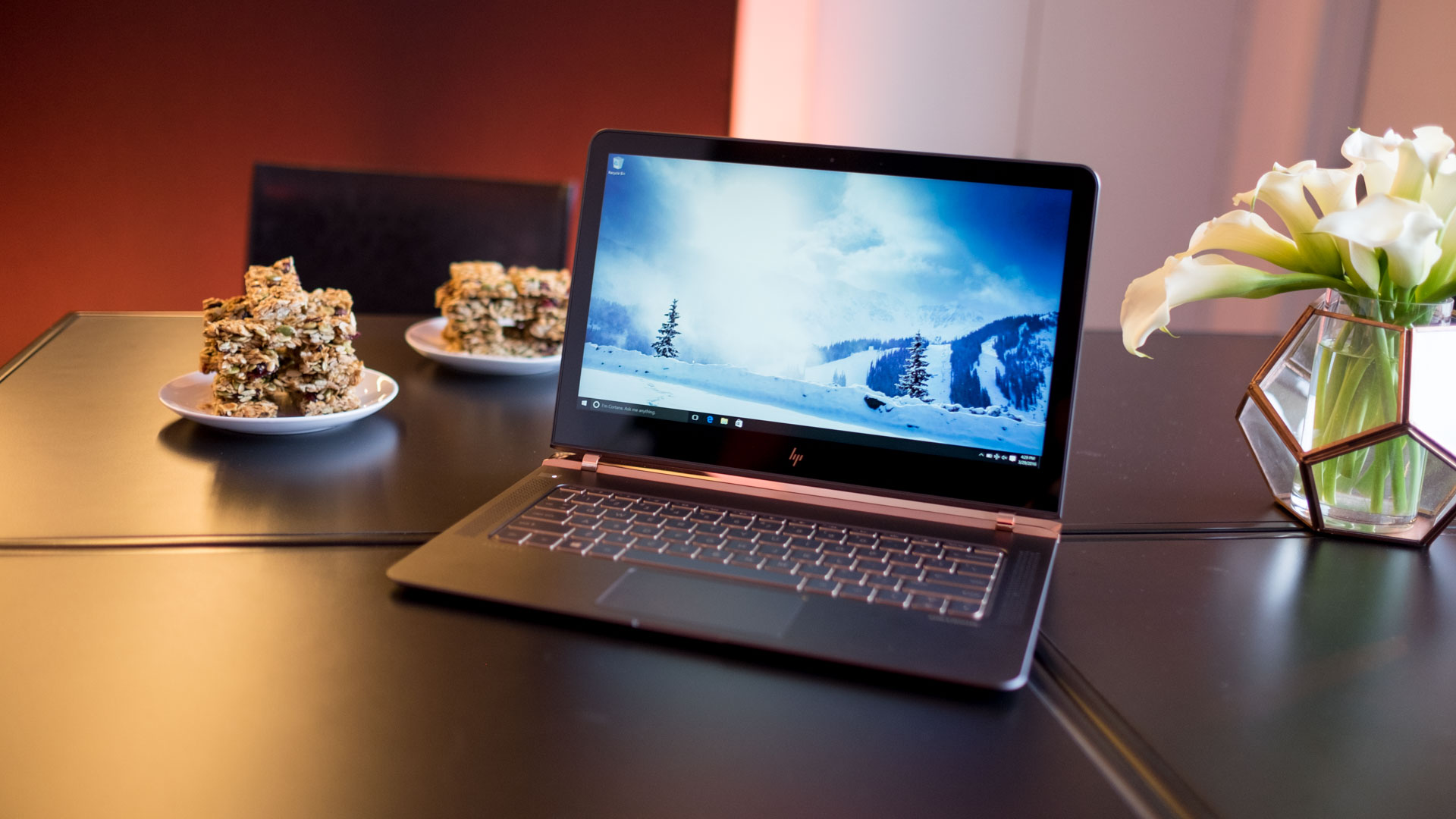Why you can trust TechRadar
While most ultrathin laptops up until now have stuck with power sipping Intel Core M processors, the Spectre comes packing a full fat Intel Core i5 or even i7 CPU. Our own configuration is the mid-range spec model, priced at $1,249 and only available in the US.
While that's a bummer for anyone across the ocean, the entry-level Spectre comes with nearly the same configuration, save for a slower Intel Core i5 processor at a more affordable $1,169 (£1,149, AU$2,399). HP also offers the Spectre with an Intel Core i7 chip and 512GB SSD for $1,499 (£1,299, AU$3,099).
Compared to competing Ultrabooks, the HP Spectre asks for a higher premium, thanks in part to its gold accents and high-end styling. For instance, a Dell XPS 13 configured to match the Spectre's starting specs is roughly 20 bones cheaper, while the $999 (about £763, AU$1,330) Samsung Notebook 9 is a much bigger bargain.
If touchscreens and high-resolution displays are must-have features on your Ultrabook checklist; you'll also want to look elsewhere, as the Spectre can't be configured with either option.
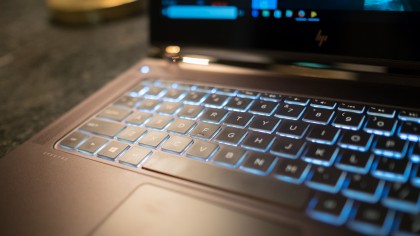
Spec sheet
Here is the HP Spectre configuration sent to techradar for review:
- CPU: 2.5GHz Intel Core i7-6500U (dual-core, 4MB cache, up to 3.1GHz with Turbo Boost)
- Graphics: Intel HD Graphics 520
- RAM: 8GB LPDDR3 SDRAM (1,866MHz)
- Screen: 13.3-inch, 1,920 x 1,080 FHD IPS UWVA BrightView Corning Gorilla Glass WLED-backlit display
- Storage: 256GB SSD (PCIe; NVMe; M.2)
- Ports: 2 x USB-C Thunderbolt 3, 1 x USB 3.1 Type-C, headphone jack
- Connectivity: 802.11ac Wi-Fi; Bluetooth 4.0
- Camera: HP TrueVision HD Webcam
- Weight: 2.45 pounds
- Size: 12.8 x 9.03 x 0.41 inches (W x D x H)
Performance
We've never felt like Intel Core M-series processors we're lacking in power, but the Intel Core i7 chip certainly gives the Spectre an extra spring in its step. Beyond everyday web browsing and email correspondence, this Windows 10 is machine powerful enough to run Lightroom and even handle some light PC gaming despite being as thin as a tablet.
HP was able to do this all by going with an unorthodox, hyperbaric cooling system, which essentially uses two fans to pull air into the laptop. That's pretty normal for any laptop, but there isn't a heat sink sitting on top of the CPU.
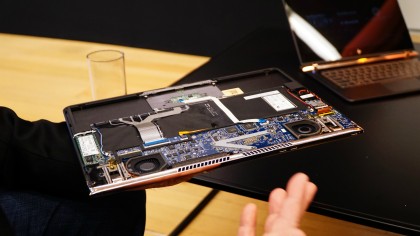
Instead, the laptop is designed with positive pressure in mind, as it funnels a stream of cool air directly over the processor and exhausts heat out through the back of the machine.
It's an effective system that keeps the CPU running at full power without throttling issues. However, this machine expels plenty of heat, and you can feel it radiating everywhere.
The laptop's carbon fiber underside gets warm to the touch, and the aluminum keyboard deck essentially becomes a hot plate. Luckily, the hot zone stays primarily above the function keys and away from your hands, but you can feel exactly where the internals are creating a geyser of heat.
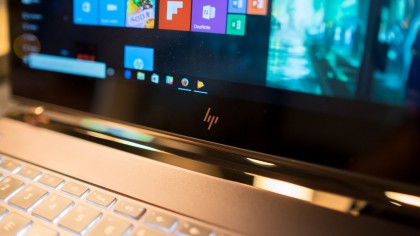
Benchmarks
Here's how the HP Spectre performed in our suite of benchmark tests:
- 3DMark: Cloud Gate: 4,703; Sky Diver: 2,746; Fire Strike: 731
- Cinebench CPU: 257 points; Graphics: 31.28 fps
- GeekBench: GeekBench: 3,172 (single-core); 6,693 (multi-core)
- PCMark 8 (Home Test): 2,615 points
- PCMark 8 Battery Life: 3 hours and 17 minutes
- Battery Life (techradar movie test): 5 hours and 33 minutes
HP claims the Spectre is just as powerful as any Ultrabook, and these figures back up that claim. The ultrathin laptop keeps in step with the Dell XPS 13 and Samsung Notebook 9 in processor intensive benchmark tests, like GeekBench and PCMark 8. That said, the Spectre lags behind in the graphical department, putting up lower 3DMark scores across the board.
This machine isn't built for any intensive graphical challenges, like video editing and hardcore gaming. But, the integrated graphics are surprisingly robust – we were actually able to play a round of Overwatch at full HD resolution with high graphics settings at a relatively solid 30 frames per second.
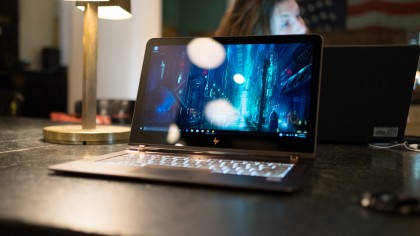
Battery life
Although HP claims users can achieve a battery life of 9 hours and 45 minutes, in our testing we found run times last about 6 hours at most. Our movie-based battery test exhausted the ultra-portable's battery cells after just 5 hours and 33 minutes, and regular usage reduced screen-on time by an hour.
The battery life numbers are well beneath the lofty expectations HP put forth, but it's still pretty impressive given how thin the Spectre is. This 13-inch notebook won't get you through a full work day on its battery cells alone, but it should be fine for long meetings or web browsing in a café – plus, fully recharging the Ultrabook only takes about two hours.
Still, if you're looking for a machine designed for longevity, you might be better served by the Asus ZenBook UX305 or a 13-inch MacBook Air.
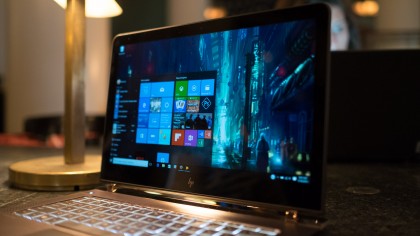
Top notch features
Aside from the premium feel and high-end style, the Spectre's most stand out feature is its bright and vibrant screen. Almost all laptop manufacturers have stepped up their display game, but this 13-inch Ultrabook in particular displays deeper blacks than even the Dell XPS 13 or MacBook.
If you're looking for the best image quality screen to watch the dimly shot scenes in Daredevil or Stranger Things, HP's Spectre is the machine to get.
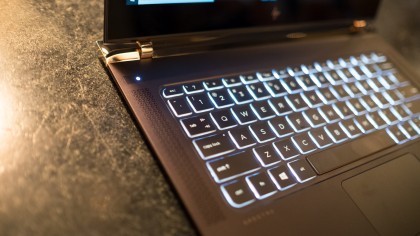
The HP Spectre also sports one of the best laptop keyboards I've ever used. Despite having to cut key travel down to 1.3mm over HP's usual 1.5mm standard, the electronics firm engineered a higher force curve, so it takes more pressure to type each key stroke. The result is a firmer typing experience and a satisfying click to go with it.
Unfortunately, the trackpad isn't as stand out and a bit smaller than all of HP's other laptops. It feels as smooth as other glass-coated touchpads out there, but it feels a little spongy when you actually click it.
Current page: Specifications, performance and features
Prev Page Introduction and design Next Page VerdictKevin Lee was a former computing reporter at TechRadar. Kevin is now the SEO Updates Editor at IGN based in New York. He handles all of the best of tech buying guides while also dipping his hand in the entertainment and games evergreen content. Kevin has over eight years of experience in the tech and games publications with previous bylines at Polygon, PC World, and more. Outside of work, Kevin is major movie buff of cult and bad films. He also regularly plays flight & space sim and racing games. IRL he's a fan of archery, axe throwing, and board games.
